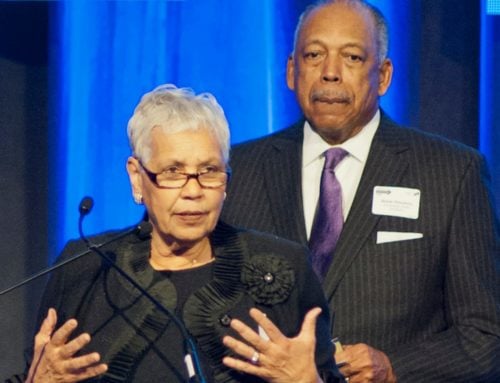By Amina Elahi
The Louisville Urban League is nearly halfway to its funding goal for a $35 million track and field facility, which it is planning to build in the West End starting next spring. On Monday, officials announced a $3 million gift for the project from the James Graham Brown Foundation.
So far, the nonprofit has raised nearly $17 million for the project, which will replace a 24-acre brownfield that’s currently on Muhammad Ali Blvd.
On the heels of that announcement, local philanthropist and Speed Art Museum Director Stephen Reily issued a challenge: If the Urban League can raise another $3 million by the end of the year, Reily and his wife Emily Bingham will donate $250,000 to the cause.
He said the track and field complex fulfills for the site some of the promise of the failed Foodport project.
“It brings a lot of the same qualities of that project to this incredible site, bringing an enormous amount of outside capital which is badly needed but doing it in a nonprofit structure that’s deliberately going to be good for the families and people that already live around this neighborhood,” Reily said.
Last year, Reily donated $300,000 to expand the League’s criminal record expungement program.
Sadiqa Reynolds, president and CEO of the Louisville Urban League, said the Brown Foundation gift brings the total raised for the project to nearly $17 million, including $10 million from Louisville Metro Government.
“The reality is, this community was energized and inspired by the potential of developing this brownfield,” she said. “And think about that we are in a community with 24 acres of contaminated land. It should not be hard to raise this money, this should be the easiest thing I have to do in my life.”
Reynolds acknowledged raising $3 million by year’s end would be a challenge, but hopes major donors will help her get there. She said she would not meet her original goal of raising the full $35 million in 2018.
The Louisville Urban League plans to break ground on the project next spring, with the goal of completing construction in 24 months, Reynolds said.
A former track athlete, Reynolds touted the facility as a responsible driver of economic development, and a benefit to area youth. She said she expects it to attract 20,000 to 30,000 annual visitors.
“I had lots of [absences] from school in the beginning of my education, and track was just one more thing that kept me in because I knew if I didn’t come to school that day I wasn’t going to be able to run,” Reynolds said.
Mason Rummel, CEO and president of the Brown Foundation, said other cities can emulate the model of the sports facility, which combines goals of health, learning, and youth and economic development.
This story has been updated to include the full name of the James Graham Brown Foundation.

